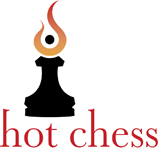Curriculum
HOT Chess Academy uses the famous Dutch Step Training Method; creative chess instruction for students in a one-on-one or small group setting.
Each Step is both 1) rating appropriate and 2) level/knowledge appropriate. Here is a breakdown of the Steps:
Step 1: Takes the student to roughly USCF Rating of 1000.
Step 2: Takes the student to roughly USCF Rating of 1100-1200.
Step 3: Takes the student to roughly USCF Rating of 1300-1400.
Step 4: Takes the student to roughly USCF Rating of 1500-1600.
Step 5: Takes the student to roughly USCF Rating of 1700-1800.
Rules of the game and basic skills are covered.
- Board and Pieces
- Moves of the Pieces
- Attack and Capture
- The Pawn
- Defending
- Check and Getting Out of Check
- Checkmate (1)
- Checkmate (2)
- Castling
- Profitable Exchange
- Twofold Attack
- Draw
- Checkmating with the Queen
- Capturing ‘En Passant’
- Notation
Tactics and a basic introduction of strategy are covered in Step 2. Most exercises require 2-4 ply calculation. The student that has mastered Step 2 can expect to attain a 1100-1200 rating.
- Activity of Pieces
- Double Attack: Queen (1)
- Double Attack: Queen (2)
- The Pin
- Eliminating the Defense
- The 3 Golden Rules
- Checkmate in Two
- Double Attack: Knight
- Checkmating with the Rook
- Double Attack: Rook, Bishop, Queen, and King
- Discovered Attack
- Defending against Checkmate
- Short Notation
Step 3 builds upon the first 2 Steps. Strong focus on tactics and the pawn endgames are introduced. In this Step, supporting skills are introduced such as ‘thinking ahead’. Exercises in this level require 3-6 ply calculation. The student can expect to attain a rating of 1300-1400 after completion of this level.
- Completing the Opening
- Discovered and Double Check
- Attack on a Pinned Piece
- Checkmate through Access
- The Square of the Pawn
- Eliminating the Defense
- Defending against a Double Attack
- Mini-plans
- Draw
- X-ray
- The Opening
- Defending against a Pin
- Mobility
- Key Squares (1)
- Pinned Pieces
- Threats
- Key Squares (2)
The difficulty level rises in this step. More ply calculations are required to solve the exercises in this step. Most exercises in this level require 5-8 ply calculation.
Strategic concepts are introduced via the endgame. This step contains lessons about material advantage and endgame strategy as well as weak pawn concepts.
The student can expect to attain a rating of 1500-1600 after completion of this level.
- Advantage in the opening
- Interfering
- Luring
- Blocking
- Thinking ahead
- Placing the front and back piece
- The passed pawn
- Eliminating of the defense
- The magnet
- Weak pawns
- Material advantage
- Chasing and aiming
- King’s attack
- Seventh rank (tactics)
- Endgame strategy
- Clearing
- Queen against pawn
For Step 5 students, the positional aspects begin to play more and more of an important role. The lessons about pawn structure, the seventh rank, strong squares and open files contain many strategic aspects. Exercises in this level require 7-10 ply calculation. Students can expect to attain a rating of 1700-1800 after completion of this level.
Playing according to a plan is important in chess and this discussed in some lessons about the endgame. They show how important the cooperation of the pieces is and how relative the value of the pieces can be. The lesson ‘Defense’ pays attention to some aspects which are almost by all the students insufficiently used.
